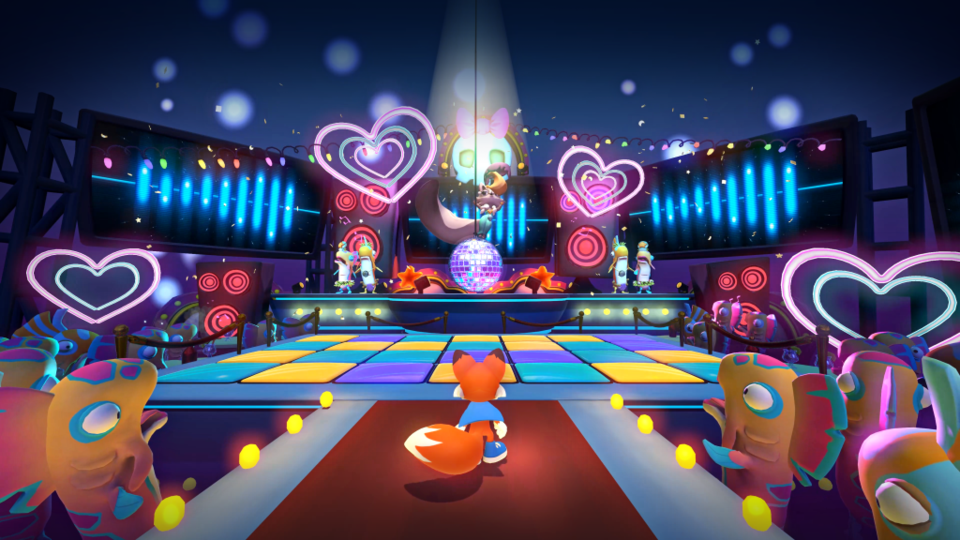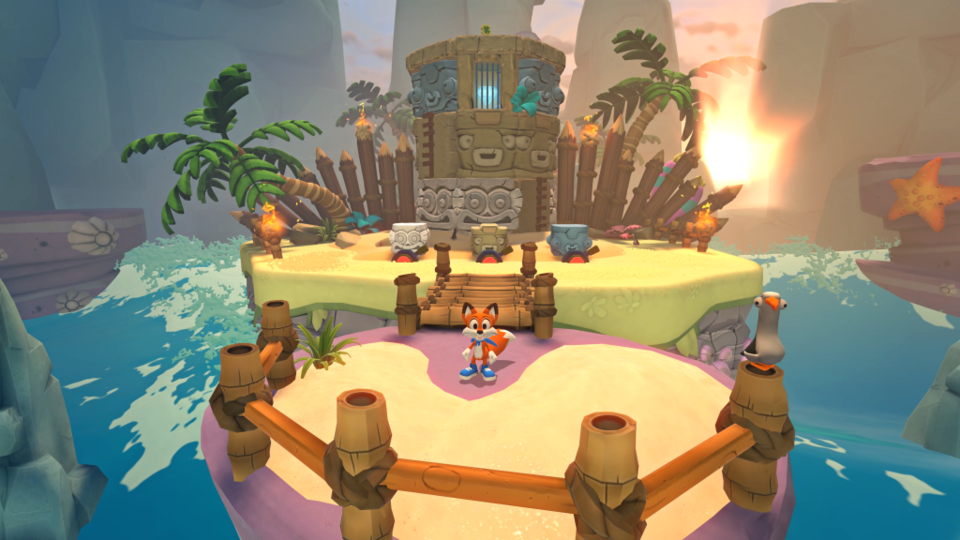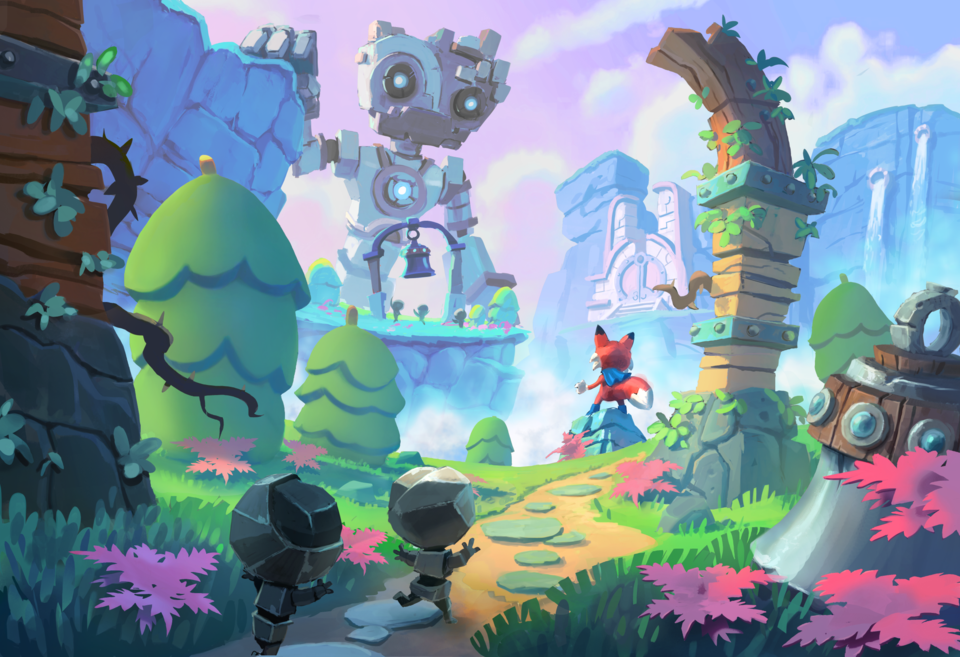"Super Lucky’s Tale" begins with a book coming into focus at the center of the screen, surrounded by darkness. It’s both woodsy and futuristic with a few leaves, and a sphere at the center glows Ironman-style blue. It tells the story of Lucky, a “carefree young fox who lived in the forest.”
One of the opening scenes shows Lucky himself, bushy tail to the camera, sitting on a dock. It’s a pastoral, soft-edged world, full of color and light. He’s fishing for funny, big-headed fish, their hungry eyes fixed on the hot dog he’s using as bait. The front door to his house is visible in the plush background, cut into the large trunk of a tree. Then the mysterious Book of Ages falls into Lucky’s life and soon, he’s off, learning Mew-shu martial arts—his teacher is a cat—collecting coins Mario-style and bouncing through an accessible world.
It’s an extremely user-friendly game, crafted for all ages, but in particular, kids. But the genius is in the details. It’s a three dimensional world, and whatever way the camera turns, there’s a little puzzle to solve, treasure to collect, enemies to stomp on or, simply, pleasant details. The skyline is beautiful, every tree has quirky crooks, and the whimsical architecture only gets more interesting, easy to engage with. It doesn’t have to be beautiful, designed with waterfalls pouring into infinity, dusty desert canyon walls, but it is. It’s all there.
Playful Studios CEO, Paul Bettner, can’t remember the name of the first console he ever owned, but he can describe it. “It had a rotating dial with basically a number pad,” he recalls. “I think that secretly my parents got it for me because my grandpa really wanted it. He was a gadget guy. But I hooked it up to our TV and played Pong for the first time.” Paul Bettner is part of the lucky generation that grew up with videogames, from Pong and that very first "Legend of Zelda," the earliest incarnation of Mario and "Ice Climbers," just collections of colored pixels. He’s never lost track of that sense of wonder he’d felt.
Today, Paul Bettner sits at the helm of Playful Studios, an independent game studio headquartered in downtown McKinney. Their flagship series is "Lucky’s Tale," an epic quest. Then there’s "Creativerse," a massive “sandbox,” where the player is free to explore, gathering treasure and overcoming objectives in an open world setting. Upcoming "Star Child" is their most cinematic platform, what IGN called “absolutely stunning.”
Playful Studios's "Lucky's Tale," was a launch title for the Oculus Rift virtual reality headset, a radical redefinition of gaming that lets players enter the world of the game. Its non-VR sequel to the game, "Super Lucky's Tale," was a launch title for the Xbox One X.

Many of the people working at Playful, including Paul Bettner, have been making games in DFW for a long time. He, like many of the other people at Playful, got his chops at Ensemble Studios, a DFW developer that, before its closure in 2009, was known for a number of strategy games, the "Age of Empires." Paul Bettner was one of the founders of a developer called Newtoy, which he later sold, and in 2013, he founded Playful.
If you don’t own an Oculus Rift or an XBox, chances are, you’ve never played "Lucky’s Tale" or "Super Lucky’s Tale." But most people, whether they identify as gamers or not, have played one of Paul’s games, because anyone who owned a phone in the last ten years has probably played Words with Friends.
“In hindsight people likes to pretend it was obvious that this game industry centered around the iPhone would be huge,” Paul says and laughs. “But I was there. At the time, we were playing Snake on flip phones; the games were controlled by the carriers, Sprint and AT&T and such. Then, the prevailing narrative was people won’t want to play games on smartphones.” But Paul and his colleagues weren’t so sure. Especially because iPhones, to him, looked like Gameboys. “But like a gameboy that everyone would own. Not just gamers,” he says. “I’m making games for people who aren’t currently playing my games.”
Read more: iGeneration: Growing up with technology
Because he and the others at Newtoy had worked on "Age of Empires," the obvious idea was to make "Age of Empires," but for the iPhone, which would have basically been "Clash of Clans." “No,” he thought. “What game would I make for my mom?”
Words with Friends was one of the most popular, engaging, widely played games ever built for smartphones. It was a new category of digital games for a new audience, built with different goals in mind. “Words with Friends isn’t built for hours of binging, but short 60-second bursts,” Paul explains. “People on phone won’t sit down for hours—Words with Friends gameplay was equivalent to the way we text, just applied to a game. It appealed to people who wouldn’t call themselves gamers.” Sure enough, his mother is huge Words with Friends player. “She wouldn’t self-identify as a gamer, but I can see that she’s playing hours a day, more than I do.” Whenever he and his wife went to the movies, they sat in the back row, so they could look down on a theater full of people playing his games.
After he sold Words with Friends, he didn’t want to jump back into mobile games. He thought about the games he’d loved as a child, and what had made them so special.
“If I could play one game like it was the first time again, it would be Mario for Nintendo 64,” he adds. Mario was the first game he ever played that upped the ante from two dimensions to three. “It was magic.”
Paul loves Nintendo, the developer behind franchises like "The Legend of Zelda" and "Super Mario Bros," and looks to them for inspiration. “They’re so courageous and they’re continually dissatisfied—always looking at who isn’t playing their games and asking how to get them playing. You don’t get it right every time—"Wii Fit," "Nintendogs"—but if you’re that courageous, you get it wrong a lot.”
But still, Nintendo 64 introduced the world to the analog stick, a revolution that made gameplay feel much more fluid, and allowed games to become 3D. When the technology doesn’t exist to serve their vision, they simply invent that technology.
“I wish I could snap my fingers and be as big as Nintendo. I have all these ideas I’d love to do if I had those resources,” Paul says.
Instead, they find hardware companies who are creating cutting-edge hardware, and partner with them, like Oculus. They first connected with Oculus when it was small. Experts considered VR a cool gimmick, but not necessarily the future of gaming, so Oculus, despite how popular their concept was with gamers, was having a difficult time getting the attention of high end game developers. But Playful Studios loved it. “It was a new experience,” Paul explains. “They needed great content and we needed a partner that could help us build this idea we loved.”
One of their team members, Evan Reedland, was the first to consider a third person VR game. Paul loved it right away and when the company did one of their regular “game jams,” where the whole staff divided into teams and everyone worked on a game idea, Paul put himself on Evan’s team. “We worked on this project called Super Capsule Brothers, because the character was just a capsule, like a Tylenol pill with Mario texture wrapped around it. We brought it to life on an early prototype of the Oculus headset.
“I remember gazing down at this world with the headset on. It was built to look like Mario. Then I looked to my left and there was the whole level stretched out. It was mind blowing. [That experience] reminded me of the first time I played Mario on the Nintendo 64. It was magic.”
When they first proposed the third person VR game that the team loved so much, the Oculus staff were skeptical. The great majority of VR games, still, are first person experiences, the player in the eyes of the main character. But the Playful team believed in Lucky.
“Finally, there came a point where we were all ready to walk away, on both sides,” Paul says. “The Oculus CEO said, ‘Let me just go play the build.’” He called Paul right away. “I just spent more time in VR than I’ve ever spent in one sitting and this is my own device,” he said. “It’s the best experience I’ve ever had. I’ll make you a deal you can’t refuse.”
That was only a year and a half after Playful was founded. Six years later, Lucky is still the heart of the company. "Lucky’s Tale" is one of the highest rated on the Rift system.
Gaming has changed from its origins; streaming, for example, has changed the way people play. For the first time, there are professional gamers and people tune in on sites like Twitch just to watch others play. The technology that led to sandbox games like "Creativerse" mean that there’s limitless potential to play a game. "Minecraft," arguably the most well known sandbox game, was so popular that in June of 2014, online video firm Octoly published a report that said that "Minecraft" videos on Youtube had been watched 30.8 billion times. “More people tuned in than actually played,” Paul says. That phenomenon is the new way forward. The spectator craze has changed the way people interact with games. “But the game doesn’t care how many people watch. Viewership doesn’t affect the game,” he adds.
But what if it did? What if there was a way to celebrate and encourage fandom, a way for spectators to contribute to the game in a meaningful way?
“There’s an opportunity to create new products, a new experience. We’ve been working on it for a couple years. Top secret things,” he lets on. He’s mostly excited by the opportunity for engagement and building community. “The way we use this art … it can be beautiful, engaging, pleasing, good gameplay, graceful movements, immersive.”
He knows that his field has a reputation as a time waster. But he’s part of a generation of developers that wants more for video games. These days, game developers delicately craft their products with details most people would never even see. The stories are deliberate and characters layered. “The industry has catered to male adolescent fantasy, to be honest, for a long time. Twenty years ago, games were being played 93 percent by men, only seven percent women playing games. But there are incredible, artistic games that are pushing the boundaries. A lot of inspiration is taken from the film industry. People waking up to obvious monetary opportunity.”
Paul lives and works by that famous Walt Disney quote: “We don't make movies to make money. We make money to make more movies.”
It’s for the love of the art first, the beauty of the play before anything else, even profit. “That’s the way creative people work,” he explains. The magic has to come before the money.

“Video games have magic. As a kid, I had that feeling of, “I had no idea this exists, this is so cool, look at this whole world.” He especially loves open world games like "Creativerse," where each player can build their own world, play their own way and discover ways of beating objectives that, possible, no one else has ever discovered. That’s the magic Paul and his team want to create. “It’s joy,” he says. “Eventually, we want people to say ‘I can’t wait to get the next Playful game.’”
Paul Bettner pauses for a moment, considering what projects have been most successful, and how he judges their success. It always seems to come back to Lucky. “With Lucky, never about VR. It’s not about the tech, but the characters.” Playful Studios has an entire team focused on developing the character of Lucky, as well as the other characters around him. “I’m trying to create as a 42-year-old for my inner eight-year-old, sure, but really, I’m creating an experience for today’s eight-year-old. Kids are so sophisticated when it comes to story and character development. We can infuse a richer story into the platform.”
Lucky has starred in two games, with a third soon to arrive on the Nintendo Switch. But perhaps his most special appearance, the true game-changer for Playful Studios, was rendering him in VR for Oculus Rift. When he was first developed for that platform, the engineers tweaked him, planning for an experience where the player is positioned in the game, behind Lucky. Paul recalls the first time he entered the game with Lucky.
“It was the first time he noticed a person in the game looking at him. The engineers made it so that if you, the player, get close and turn your head toward him, he looks up at you. And if you do that for a while he waves.” He grins. “There was this sense of connection to this character, beyond anything. It was just magic.”




